Cumquats are my least favourite citrus fruit by a long way, but they’re also my favourite citrus tree. The structure of the tree is looser, and the leaves have a much more delicate quality than other citrus trees.
If you’re a fan of their fruit, then they’ve got everything going for them, but for many, that intense bitterness of just-ripe cumquats is too much. Regardless of my personal distaste for cumquats, I do love growing them.
They add a gorgeous architecture in pots and large planters and are slow-growing enough that it’s easy to plan a garden around them. For help and advice on growing cumquats at home in Australia, read on for everything you need to know.
More...
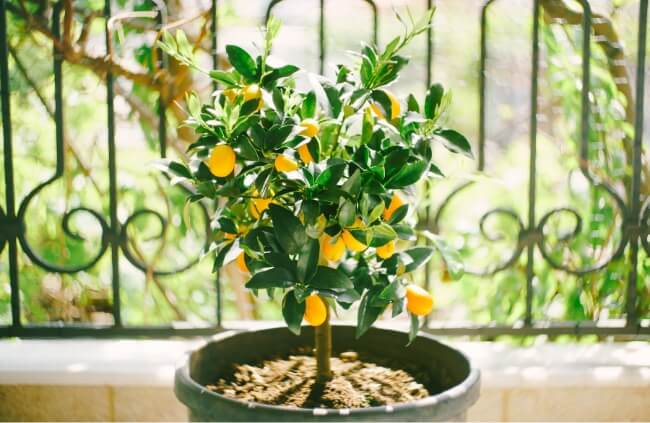
Family: | Rutaceae |
|---|---|
Genus: | Citrus |
Species: | Various |
Common Names: | Kumquat, Cumquat |
Origin: | Southern China |
Location: | Outdoor |
Type: | Citrus tree |
Growth: | Up to 4.5m tall |
Sun requirements: | Full sun |
Foliage Colour: | Green |
Flower Colour: | White |
Flowering: | Summer |
Edible Parts: | Edible fruit |
Maintenance level: | Medium-high |
Poisonous for pets: | Fruit is non-toxic. Chewing bark may cause gut problems. |
What is a Cumquat Tree?
Cumquats are small citrus fruits, typically orange, but sometimes yellow or even green. They grow on trees similar to other citrus fruits, but typically with finer foliage, and denser flowering.
Cumquat trees grow to about 2m tall, but some species and cultivars can reach 4m or more, but all are relatively short trees, and all have incredibly long lifespans. The challenge for most cumquat growers is that their trees are bought very young, usually as houseplants.
They are slow growing, and quite picky about their positions, so starting small isn’t usually the right choice, as they much prefer to be outdoors in Australia, where they benefit from long, warm summers, and plenty of sunlight.
Uses for Cumquats
Cumquats are particularly astringent and can be incredibly bitter, but they have a distinct fragrance more like bergamot than most other citrus (not surprising given that bergamot orange rind share that same unforgettable flavour).
Because of that, they make excellent marmalades and jellies, and candied cumquat peel is on another level. And, if you don’t mind their raw flavour, they can be eaten without any prep, and even the skin of these citrus fruits is edible.
Cumquat Tree’s Natural Habitat
Cumquats are native to Southern China but are now found growing pretty much everywhere in the world, including cooler, more temperate parts of Europe. In Australia, they grow really well in containers outdoors, provided they have good drainage and plenty of nutrition.
In their native habitat, cumquats, like most citrus, grow as fairly solitary trees in open land or at the very edge of woodland, where they tend to form multi-stemmed trees or large shrubs.
Cumquat Varieties to Grow at Home
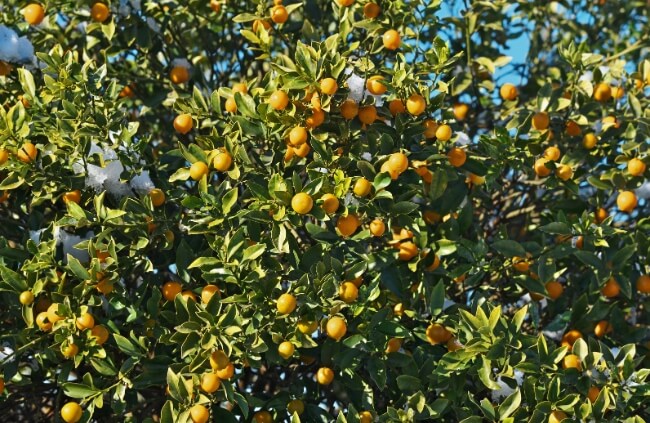
There are quite a few cultivars of cumquats out there, and the variety is impressive, with all shades of yellows, oranges and greens, including some variegated fruits that can be grown easily in Australian gardens.
I’ve plucked out five of the best below, which will all do well in nearly all Australian gardens, provided they have good sun and plenty of liquid feed. There’s more about how to grow and care for cumquat trees later.
1. Hong Kong Cumquat (Fortunella hindsii)
In native Southern China, the Hong Kong cumquat is the only cumquat still growing wild. It has the smallest fruits of any cumquat, and possibly of any citrus, with rich reddish-orange skins and very little juicy flesh.
The rind is packed with flavour and makes an excellent addition to other citrus recipes, but its main attraction is the tree itself, with deep-green elongated leaves, which form a beautifully dense shrub when pruned to grow as a multi-stemmed specimen.


Get Your Free Guide:
Master Growing Australian Natives eBook
A Must Have Complete Guide for Every Australian Garden
Get Your Free Guide:
Master Growing Australian Natives eBook
A Must Have Complete Guide for Every Australian Garden
2. Jiangsu Cumquat (Fortunella obovata)
Jiangsu cumquats produce gorgeously ornate fruits, which develop into a pear shape when fully ripe. They have more flesh than most, so are great for recipes that just require cumquats with no other fruit.
The trees are slow growing, reaching an ultimate height of about 3m tall, and less in containers. Regardless of how you grow Jiangsu cumquats, they will generally produce a wealth of fruit whether you’re pruning an ornamental lollipop shape, or leaving them to grow wild.
3. Malayan Cumquat (Fortunella polyandra)
Malayan cumquats are smooth-stemmed with large leaves. If you’ve ever struggled to grow lemons or other citrus trees but want a similar structure in the garden, these are a much simpler alternative to grow, and their medium-sized fruits are very versatile.
4. Meiwa Cumquat (Fortunella crassifolia)
The largest fruited cumquat tree available for general cultivation is the Meiwa cumquat. Its fruit is still small compared to most other citrus, but does have a colourful impact when they begin to ripen.
It’s the diminutive foliage of Meiwa cumquats that makes it special for me though, offering far more structural interest than any other citrus, thanks to its dense foliage, which fills every inch of young growth and allows for really tight pruning back to a node after harvests.
5. Oval Cumquat (Fortunella margarita)
Also called the Nagami cumquat, the oval cumquat is the most commonly sold cumquat in the world. It’s native to China, but cultivated in Australia and warmer parts of Europe.
It has, perhaps, the least appealing form, in that it is a fairly standard citrus tree, but it’s still a beautiful addition to a garden and works well when pruned as a standard with a single bare stem supporting a round mass of clipped growth on top.
6. Variegated Cumquat
The variegated cumquat (Citrus japonica) is the most unusual of all, with both variegated fruit and variegated leaves. It grows to about 3m tall even in the ground but thrives in pots with plenty of liquid fertiliser throughout the flowering and fruiting stages.
The variegations are most visible before the fruit ripens, but even once ripe, its skin holds onto delicately striping, and the leaves are vibrantly splashed with deep green and white.
How to Grow Cumquats in Australia

Cumquats really don’t like standing in wet soil, so there is some prep to do if you plan to grow them directly in garden soil. Generally speaking, they are easiest to maintain in pots and containers, but it will restrict their growth.
The choice is up to you, but there are guides to preparing and caring for cumquats in pots and in the ground below.
Soil and Drainage
Drainage is important to cumquats. They don’t like being too wet, but they also need consistent access to nutrients at every stage of growth. If you have chalky or sandy soil, mix in plenty of organic matter to improve nutrients and balance out the pH of the soil.
If you have clay soils, mix through gypsum to help improve soil structure, maintain even drainage through the seasons, and unlock inaccessible nutrients from the soil itself.
Water Requirements
Cumquats might like good drainage, but that doesn’t mean they don’t need water. In pots, they will need a weekly, if not twice weekly drink through summer, and regular feeding to go with it.
In the ground, cumquats can be left to their own devices, but if you have a very well-drained garden or an exposed windy site, it's worth maintaining soil moisture with a weekly drink to support foliage health.
Ideal Planting Location for Cumquats
Like any citrus, cumquats are at their best in full sun. That goes for the plant as much as the fruit. The fragrance from cumquats in particular, as they ripen, on a hot day is unbelievably rich, and the more light they get, the more sugars they can produce.
While those sugars don’t translate into sweetness, they boost the flavour of the rind in particular, giving more of that captivating flavour for your jams and jellies.
Planting Cumquats in Pots
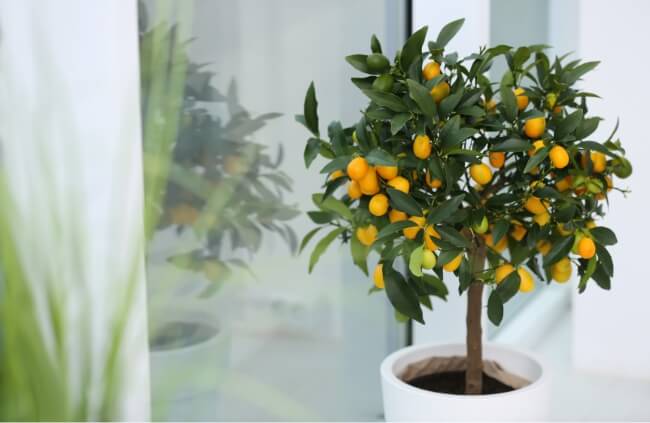
To plant cumquats in pots, start with a pot that’s about twice the size of the existing root ball. So a newly bought cumquat in a 2L pot will need a 4L pot, etc. Use a draining pot, like terracotta pots that will give indications of water levels by its colour and make care easier too.
Add a generous layer of chocks, grit, gravel and drainage to the base of the container to make sure the plant is never sat in trapped water, and then add a citrus compost mix to the pot before planting directly into it.
A good citrus compost should be quite sandy but hold together when squeezed as it needs plenty of organic compost to feed the plant and hold just the essential moisture.
How to Prepare the Ground for Outdoor Planting
Cumquats planted directly in the garden will grow bigger and produce more natural shapes. Some older cumquats in a garden near me were clearly knocked over by the wind when they were young, but their mature stems now have a gorgeously curved form that leads to a bounty of fruit every year.
Make sure drainage is okay, and then plant your cumquat in a spot with maximum sunlight.
How to Propagate Cumquats
It’s very possible to grow your own cumquat trees from seed, or even cuttings but they are slow growing and take several years before they will flower or bear any fruit. And, ideally, that fruit should be removed until your cumquat tree is at least 1m tall so it can keep focussing on rooting.
However, if you’re patient, like a project, we’ve put guides on growing your own cumquat tree from seeds or cuttings below.
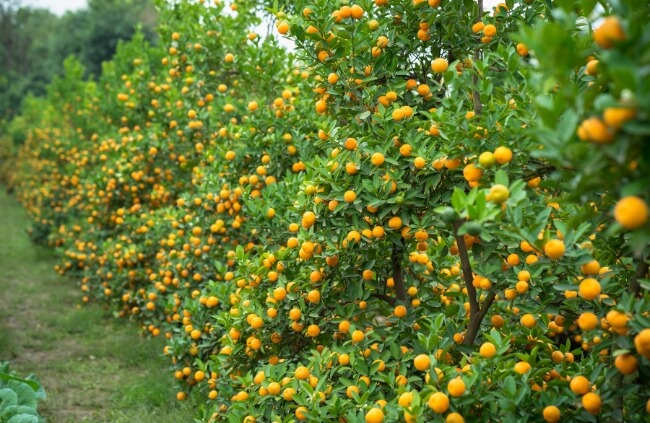
Propagating Cumquat Trees from Seeds
To grow your cumquat tree from seeds, you’ll have to start with the fresh seeds of a fully ripe cumquat. Saved seeds have a low germination rate and germinate much better when the centre of the seed is still green.
- After harvesting, remove the seeds from the cumquat fruit, and let them dry out for 48 hours.
- Place each seed on a piece of damp paper towel, fold it over, and place it in a sealed plastic bag.
- Leave the bag somewhere warm and bright, but out of direct sun for about four weeks, and you should start to see signs of germination.
- Once the germinated seed has a 1cm shoot, add it to a pot of very well-drained compost, so the root is facing down and the seed is just covered by compost.
- Water gently and keep the soil evenly but lightly moist until the seed has developed a main stem and several leaves.
- Protect the seedling from direct sunlight until it’s about 15cm tall, and has at least three sets of leaves, then treat it like you would a mature plant – full sun, good drainage, plenty of warmth.
Cumquat Tree Propagation from Cuttings
Cumquat tree cuttings, like most citrus trees, are not particularly reliable, so take several cuttings and assume most won’t work. The process isn’t time-consuming or costly, so take as many cuttings as your cumquat plant can afford to lose, and propagate themselves somewhere bright, warm and humid for best results.
- Start with 15-20 cm softwood cuttings of your citrus tree in spring or early summer, cutting just above a leaf to encourage new growth on the original tree.
- Trim your cutting to just below the lowest node or leaf, and remove the bottom two-thirds of the foliage.
- Dip the cutting into a glass filled with water and a few drops of rooting hormone.
- Leave it there for a week or two, until roots have formed – changing the water if it becomes cloudy.
- Once roots have formed, plant the cutting into a gritty compost mix, or a free-draining mix of compost and perlite.
- Mist or water the cuttings regularly and leave them somewhere with some direct light, but no midday sun if possible.
- Once new growth appears, move them somewhere brighter and care for them like any other citrus plant.
Caring for Cumquat Trees
Cumquats are surprisingly hungry plants, but they’re not particularly picky about what you feed them, so ongoing care, while regular, isn’t complicated. Follow our guide for caring for established or semi-mature cumquat trees below.
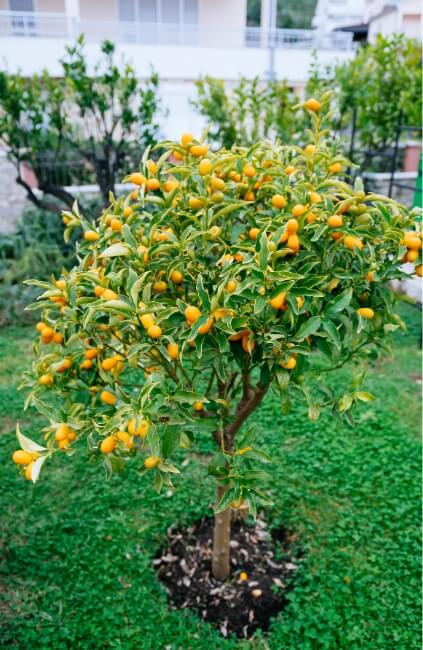
Mulching Cumquat Trees
Cumquat trees benefit from organic mulches. Apply liberally mulches of rotted horse manure, chicken manure pellets or garden compost once every two years to the base of a cumquat tree for even, slow-release feeds that help to maintain soil health too.
For more decorative, but equally useful mulches, apply liberal amounts of shredded bark, which will retain moisture but allow you to manage feeding more directly.
With any mulch for cumquats, and other citrus trees, keep it at least 10 cm away from the trunk of the plant to avoid any damp problems right at the base of the plant.
What Fertiliser to Use
Cumquats love any balanced liquid feed or liquid soil improver. We use tomato feed and liquid seaweed once a month, alternating between them in summer.
In week one, just water; week 2, seaweed feed; week 3, just water; week 4, tomato feed.
It’s a simple system that works for most citrus fruits in summer, and for most of the year means you can sit back without watering or feeding them at all.
Pruning Cumquat Trees
Cumquats produce flowers and fruit on new growth, so if you want to maintain a formally shaped cumquat tree, prune directly after harvest, back to a leaf or node below the new growth.
This will promote next year’s flowers and fruit on pruned citrus, but if you simply leave it alone, you’ll end up with a beautiful tree that naturally develops new shoots where it needs them, so pruning isn’t necessary for more natural looking cumquats.
Repotting Cumquat Trees
Cumquat trees are usually happy to be restricted in their pots, but do try to choose a grafted cumquat – they’ll be sold as a dwarf cumquat, on grafted rootstocks of smaller citrus varieties.
For any sized cumquat though, if it’s slowing down, and the roots are winding around and around in its container, you can root prune it with good outcomes, simply by trimming the root ball and adding fresh compost around the outside in late winter while the tree is dormant.
When to Harvest Cumquats
Cumquats are easy to harvest, and harvesting some will help others to ripen, similar to peppers, which develop simultaneously but ripen unevenly. They are ready to harvest when their skins darken, and they give slightly when squeezed. Simply twist them off the plant and place them gently in a basket.

How to Store Cumquats
Once harvested, cumquats will keep at room temperature for about a week, slightly more in the fridge. For long-term storage, put fresh cumquats in the freezer in an air-tight bag, and defrost slowly at room temperature when you’re ready to use them.
Freezing cumquats will change their texture, but for jellies, or using the rind to flavour other foods, it’s a good way to store whole fruit.
To store just the rind, you can peel cumquats and dry the rinds in a well-ventilated sunny spot, or in a low oven. The dried rinds can last for up to a year in a sealed jar.
Common Cumquat Tree Problems
Citrus fruits are pretty resilient in Australia, particularly outdoors, but occasionally some pest problems become persistent, and disease becomes recurring and requires action.
For the most part, cumquats are fairly bombproof, provided they are planted in the right position.
Cumquat Tree Pests
There are four common pests that cause problems for cumquat trees, and citrus in general:
- Leaf miners
- Mealybugs
- Scale
- Spider mites
Others include aphids, whitefly and thrips, but they are less common and less damaging, and the treatment for each is fairly similar.
Leaf miners
Leaf miners are problematic in that they are very hard to spot, and cause damage before you see it. They are a type of caterpillar that lives inside the leaf, creating channels and grooves that are very susceptible to fungal problems in damp conditions.
Check for leaf miners by holding a leaf up to the light, and checking for trails throughout the leaf.
Mealybugs & Scale
Mealybugs and scale are a common sight on citrus plants. The waxy leaves offer a great host for mealybugs and indoor plants in particular tend to offer just the risk mix of healthy foliage, moist soil and shelter.
The easiest way to prevent and remove mealybugs or scale is to reduce watering as they need moist soil to thrive. Water potted cumquats from the base to keep the surface soil dry, and treat heavy infestations with neem oil.
Spider mites
Spider mites and mealybugs tend to be alternating problems for us here. Where mealybugs need damp surface soil to lay and hatch, spider mites need dry soil. If you notice spider mites, spray peppermint essential oil around the base of the plant, or spray weekly with neem oil until the problem stops.
Cumquat Tree Diseases
Various fungal problems can occur on citrus trees, mostly as a result of wet weather combined with any of the pests above. However, some diseases and fungal pathogens can cause problems without preceding damage.
Root rots, anthracnose, and citrus blast are common with any citrus tree, and cumquats are no different.
Root rot
The most common root rot in cumquats is caused by a soil-borne fungus called Armillaria. It’s common in many similar species, including all citrus, some soft fruits, and avocados in particular.
Essentially, in warm but damp soil, that holds moisture more than it drains, roots will begin to rot away, leading to defoliation and proof fruit formation in the first year. In the second year, the fungal problem can spread up the stem, causing mushy bark and rotting wood at the base of your cumquat.
There is no treatment for established cases, and even if caught early you will need to cut out any and all damaged roots and replace the soil to give your tree a chance.
Anthracnose
Anthracnose covers a group of fungal diseases which are easiest to notice on the leaves. Leaves will develop pits and sunken sections, which crinkle and turn grey. The problem will begin from a point of damage and spread to petioles, stems, and later trunks.
In many cases, it simply self-manages, and all you need to do is remove affected leaves, and gather leaf litter so it doesn’t sit in the soil.
Citrus blast
Citrus blast looks, quite literally, like someone has blasted your citrus tree with a blow torch. Leaves dry out quickly, and die back into stems and branches, eventually killing the entire tree.
The disease is quick to spread and needs heavy pruning to remove it from the tree entirely. Cut out any brown, dry-looking growth and then burn it. Repeat with any reoccurrences.
Cumquat Tree Frequently Asked Questions
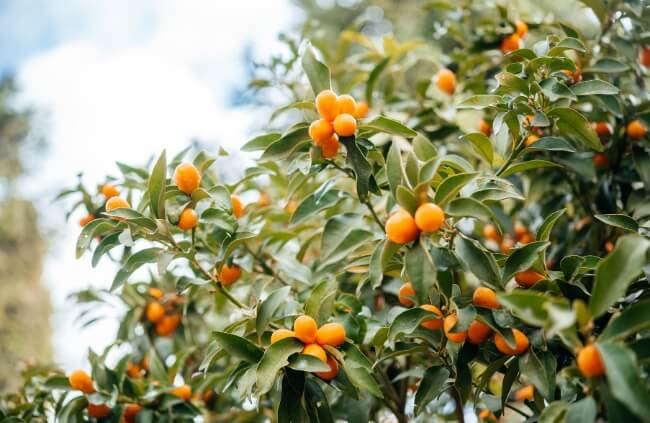
How long does it take for a cumquat tree to fruit?
Cumquat trees take about six years to develop their first fruit if grown from seeds or cuttings, but those from grated cuttings are faster. After panting, expect a period of about two or three years before even mature cumquats begin to bear fruit again.
Are cumquats indoor or outdoor plants?
Cumquats are reasonably frost-hardy, but shouldn’t be exposed to prolonged frost, or damp winters. If you live anywhere with cold wet winters, consider growing cumquats indoors, or at least bringing them indoors for winter.
Do cumquat trees fruit every year?
Cumquats produce fruit every year. There are situations where some citrus will only fruit every two years, but in most cases cumquats not only fruit annually but can fruit twice a year.
Are calamondins and cumquats the same?
Calamondin, Citrus mitis, is a naturally occurring citrus, and likely a hybrid of cumquat and mandarin. They are similar, but calamondins have thinner, less flavourful rinds.
Can cumquats be eaten raw?
Cumquats can be eaten raw, and the rind is generally sweeter than the flesh – though neither is particularly sweet. If you don’t like bitter, astringent flavours, raw cumquats probably aren’t for you.
Why are my cumquat tree’s leaves turning yellow?
If the leaves of your cumquat tree are turning yellow it is usually a sign of nutrient deficiency. This can be caused by both under-watering and over-watering, as well as simply poor soil. Soil conditions will give you a big clue as to the cause, and therefore the treatment for yellow cumquat leaves.
Why is my cumquat not setting fruit?
If your cumquat tree is not setting fruit, it is likely due to low light conditions. They require a lot of sun to process the sugars needed to develop pollinated flowers into fruit, and that comes from photosynthesis, and nothing else. So sunlight is essential for healthy fruiting cumquats.
Wrapping Up Our Guide to Growing Cumquat Trees in Australia
These precious pops of flavour, packed with notes of bergamot and lime are completely unique fruits to grow, and their trees are really quite special, with fine, delicate foliage, and a good response to pruning and clipping, they make handy additions to formal planting.
Their finer foliage makes them just as good for more natural planting too, with wild, unkempt stems, with bountiful berries, easy to achieve in most Australian gardens, making the cumquat tree a great choice to grow at home.
Published on November 5, 2023 by Nathan Schwartz
Last Updated on February 25, 2024





Hi,
I am looking for some help to identify a problem I have with my cumquat tree.
It appears to be a fungus, but I am uncertain.
Can you suggest where I might send details and photos to an expert who ay set me straight on what to do?
Thank you
Hey Keith, thanks for reaching out email images and details to [email protected] and we will be able to help you out.
Our cumquat tree almost died from not being watered enough while we were away in October. Pruned off most dried leaves and branchlets; after a few weeks, it miraculously sprouted some green shoots, well up on branches which had previously flowered and borne fruit. Now, in June, the whole tree has plenty of green foliage but not the slightest sign of a bud. Previously it flowered and fruited a lot. Will it fruit again?